A black and white bird with a red head is a beautiful sight. In North America, there are various birds that spot this unique plumage and in the article below we’ll look at a few.
From small birds like the red-headed finch to the medium sized red-bellied woodpecker to large birds like the redhead, there are plenty of birds to add to your bird-watcher’s list. The birds below are very intelligent and melodious. We’ll also look at the feeding and breeding habits of these black and white birds with red heads.
List of Black and White Birds with Red Heads
1. Red–bellied woodpecker

Red-bellied woodpeckers are medium-sized wild birds found in eastern North America. It is a member of the Picidae family that consists of other birds in the woodpecker family.
Identification:
The bird has a white barred back, white face and belly. It has a red cap and nape. Females have similar plumage as the male without the red cape.
Sexes are medium sized, measuring between 9 and 10 inches long, with a wingspan of 13 to 17 inches.
Interesting facts:
Red bellied woodpeckers are found in deciduous forests, bottomland forests, as well as parks and suburban areas. The bird feeds on insects, primarily ants, but will also eat berries and nuts. Nests are typically excavated in dead trees or stumps, but the birds will also use man made structures like fence posts or buildings.
How long does the red-bellied woodpecker live? About 10-12 years in the wild. Their nesting season starts from March with the female laying 2 to 6 white eggs that are then incubated for roughly two weeks.
2. Red-crested cardinal

One of the most common birds in Hawaii, the red crested cardinal is a medium size bird for the cardinal family. How can I identify these red headed birds?
Identification:
The red crested cardinal is a striking North American bird that is easily recognized by its bright red head, similar to the Northern cardinal. As for the rest of the body, the breast, belly, and undertail are all white white the back is gray with black tips on the wings.
Immature birds have an orange-brown head and bib.
Interesting facts:
These adaptable birds are cavity nesters, meaning they build their nests in natural or man-made hollows such as tree cavities, birdhouses, or mailboxes. Cardinals are also songbirds, and their cheerful “cheer-up” song is a familiar sound in many neighborhoods.
Male cardinals are territorial and will vigorously defend their territory against other males; females are much less aggressive. These handsome birds typically live for four to six years.
3. Red-headed woodpeckers
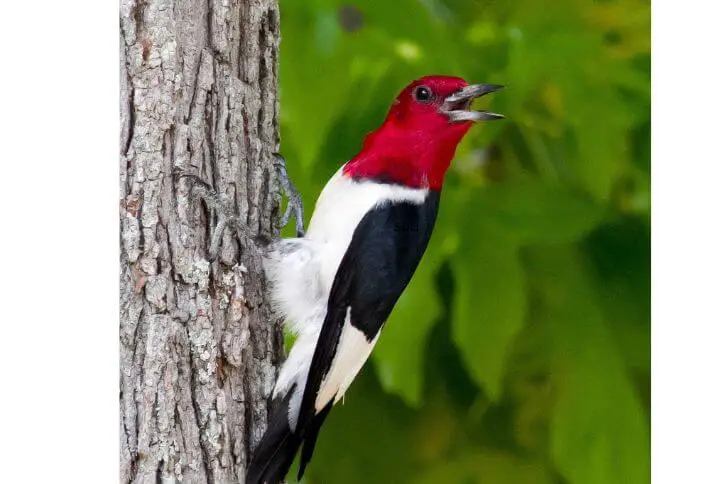
What states do red-headed woodpeckers live in? You can easily find these birds across North America; mostly in Eastern United states where they are resident breeders. How can you identify them from other woodpeckers?
Identification:
They have a characteristic bright red head, black above and white below. Note the wings are black with a mid white patch.
To identify the juvenile, be on the lookout for a nest with babies that spot a brown head, reddish cheeks, black back with white stripes.
Also you can identify them by their call. Red headed woodpeckers are known for their loud shrills “tchur” and drumming sounds produced by continuously tapping the bark of a tree.
Interesting facts:
Red headed woodpeckers typically live in forests or other areas with plenty of trees, and they eat insects, nuts, and fruit. They are not considered an endangered species.
During the breeding season, the male has to find a suitable spot to build their nest, which takes about 3 weeks for both sexes to build. They raise 1-2 broods per year.
4. Pine grosbeak

Pinicola enucleator or Pine grosbeak is the only member of the genus pinicola. This red headed bird is found across most northern States.
Identification:
It is a medium size bird, about 7.9-10 inches in length with a wingspan of up to 13 inches. To identify the male pine grosbeak, be on the look for a chunky bird with a rose-redhead, back and breast. Its wings are a mix of gray, black and white tips.
In contrast the female pine grosbeak spotted a yellow-orange head and rump, gray chest and belly and black and white wings.
Other facts:
These birds eat mostly seeds, but also insects and fruit. They build their nests in trees, and lay 3-5 eggs. They prefer coniferous forests where they perch on trees with abundant seeds. Their songs are similar to purple finches’ songs.
Their warbling songs are a series of notes that they produce for 3-5 sounds. They are also known for their flute-like melody and “tee-tew” sounds.
5. Hairy woodpecker

What is the range of the hairy woodpecker? They are found all over North America but some groups have been known to move to coastal states during winter.
Identification:
The hairy woodpecker male is a medium-sized woodpecker that has a black back, white underneath and two white stripes on the head. Note the long bill and the red patch at the back of its head.
Though small, the red head patch enables bird watchers to tell males apart from females. Female hairy woodpeckers have similar plumage without the red patch.
Interesting facts:
They use their sharp beak to peck at tree bark to find insects to eat, and they also use their long tongue to extract insects from inside tree crevices. Hairy woodpeckers build nests in trees, and the female lays 3-5 eggs.
These birds are very beneficial to forests because they help keep trees healthy by eating the insects that can damage them.
Want to attract these wild birds to your backyard feeders? Black sunflower seeds, peanut butter and suet will bring them to your backyard.
6. California condor

The California condor or the Gymnogyps californianus is a New World vulture, the largest North American land bird. These condors are one of the heaviest birds in North America, with wingspans up to 9.5 feet (2.9 m).
Identification:
Because of its size, this black and white bird with a red head is easy to spot and identify. Both sexes spot black feathers on their body with white underwings. Their head is naked, giving it the head plumage.
Immature birds are grayish, getting the adult plumage at 6 years.
Interesting facts:
Condors live in the highlands of central and southern California, northern Baja California, and Arizona. They forage on the ground or in trees, feeding mainly on carrion but also eating small animals.
Since the late 1990s, condors have been released into the wild to reestablish self-sustaining populations. As of 2019, there are more than 430 free-flying condors across California and Arizona.
And unlike most birds, they do not construct elaborate nests. During the breeding season, females will construct nest holes and lay one egg per season that hatch after two months.
7. Red-breasted sapsucker

source; christinegaio
A red-breasted sapsucker drills perfectly round holes into trees to access the sap within. It then laps up the sap with its tongue, often returning to the same tree day after day.
Identification:
Both male and female red-breasted sapsuckers have a red breast and head, white-black streaked belly, and mottled black back. Also they are easily identifiable by the white mark between the bill and eyes.
Speaking of the bill, it’s sharp and black. It’s thick enough to drill holes into tree trunks. These birds are relatively small, measuring only about 7-8 inches in length.
Interesting facts:
Red-breasted sapsuckers are found throughout North America, from Alaska and Canada all the way down to Mexico. Their breeding habitat is typically coniferous forests, though they can also be found in deciduous forests and even suburban areas.
8. Crimson-breasted woodpecker

source: savitha_ravi_
Scarlet-breasted woodpecker or crimson breasted woodpecker is a beautiful bird that is native to the forests of Central and South Asia.
Identification:
The male bird has a red breast, while the female bird has a gray breast. Males have a bright red patch towards the back of their neck. Both sexes’ backs have similar coloration, black and white.
Interesting facts:
These black and white birds with red heads feed on insects and larvae that it finds in trees. They nest in tree cavities and lay 4-5 eggs at a time. They are known for their loud “chick” sounds.
9. Scarlet honeycreeper
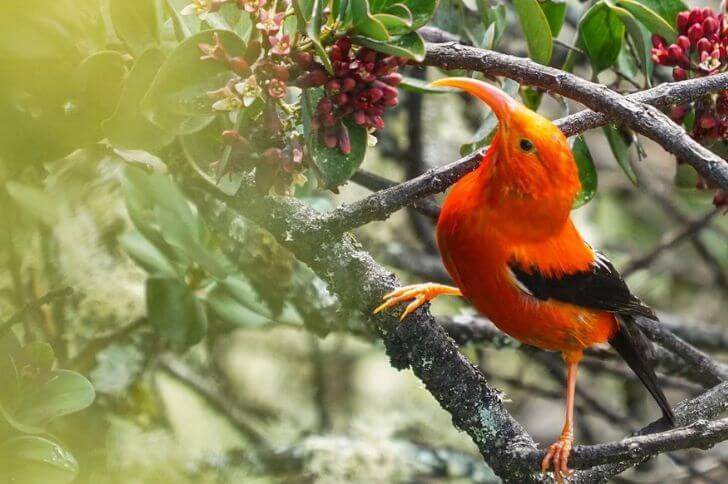
source: birdinghawaii
Scarlet honeycreeper or the ʻiʻiwi is a beautiful bird that is found in Hawaii. It is a member of the Hawaiian honeycreeper family and genus drepanis, that has two other bird species; Hawaii mamo and Black mamo.
Identification:
The adult ʻiʻiwi are a bright scarlet red on their head, underneath and rump. Scarlet honeycreepers also feature black tails and wings with white spots. Scarlet honeycreeper babies are a mix of orange, green, and yellow.
All birds in this family have a sharp curved bill that comes in handy when foraging for food.
Interesting facts:
What do scarlet honeycreepers eat? These birds are nectar feeders and can often be seen flitting from flower to flower in search of food. They play an important role in the pollination of many plants in their native range.
The Scarlet honeycreeper is currently considered to be at risk of extinction, due to habitat loss.
Deforestation not only destroys the trees that these birds nest in, but also eliminates the flowers that they feed on. If habitat loss continues at its current rate, the Scarlet honeycreeper could become extinct within our lifetime.
10. Scarlet honeyeater

Not to be confused with the scarlet honeycreeper above, scarlet honeyeaters are another group of black and white birds with red heads. Also known as the scarlet myzomela, this bird is a resident breeder in Australia. Here is how to identify it easily.
Identification:
Females and males have different coloration. Are olive-brown above and paler below. Note the reddish tinge on their face. Males spot bright red heads, a predominantly white belly and black wings and tail.
Interesting facts:
The bird is a member of the Honeyeater family, and feeds on nectar from flowers. It is found in forests and woodlands, with eucalyptus trees, across Australia. The bird has a very distinctive call, which sounds like “chiew-chiew”. The bird is often seen in pairs or small groups, and occasionally alone.
The Scarlet Honeyeater is an important pollinator of native plants.
Related Read: Here is a list of black birds with red chests
11. Red siskin

Another endangered black and white bird with a red head that made it to this list is the red siskin. You may not have heard of it because it’s found in tropical South America and is rarely seen due to its dwindling number but here is what you need to know about it.
Identification:
Red siskin or the Spinus cucullatus is a small, neotropical finch. It is found in the northern Andes of South America, from Venezuela to Peru. The red siskin has a bright red body with black head wings and tail. Note the undertail is white.
It is one of the most colorful birds in the world. The red siskin is an important bird in the wild because it helps to disperse the seeds of various plants.
Interesting facts:
The red siskin is a very popular bird in captivity. It is often kept as a pet or breeding bird. Unfortunately, the wild population of red siskins is declining due to habitat loss and capture for the pet trade.
12. Yellow-bellied sapsucker
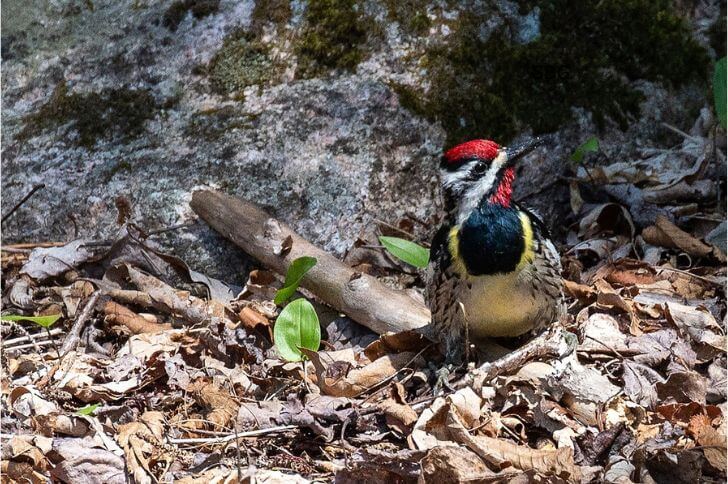
Famous for its nasal “owee-owee” and “kwee-urk” calls, the yellow bellied sapsucker bird is a small to medium sized woodpecker that is found in North America. It favors conifer and hardwood forests of Northeastern United States and Canada.
Identification:
The adult male has a red throat and crown, vertical white patches on their black back, and white underneath. On the other hand females have white to yellow underparts, a white throat and red crown.
Both sexes spot stout bills. The juvenile is duller in coloration.
Other facts:
These birds are known for their habit of drilling holes in trees and sucking the sap. They also eat insects and fruit. The yellow bellied sapsucker bird is considered to be a pest by some because of the damage they can do to trees.
Like the red headed woodpeckers, they also enjoy sunflower seeds. They are monogamous, spending at least three weeks excavating their nests.
13. Flame-colored tanager

The Flame Colored Tanager is a beautiful bird that is found in the rain forests of Mexico and Central America. It occasionally visits the United States.
Identification:
The male of the species is a striking red color with black wings that have white spots on them. Females are also beautiful with olive-green and yellow plumage underparts and black wings.
Interesting facts:
These birds are insectivores, and their diet consists mainly of ants and other small insects.
The Flame Colored Tanager is an important part of the rainforest ecosystem. They help to control the population of insects, which can be damaging to the forest if left unchecked.
In addition, their bright plumage makes them a popular subject for photographers and bird watchers alike.
14. White-winged tanager
A member of the tanager family, the white-winged tanager is a gorgeous that prefers coffee plantations and pine forests in Central and South America.
Identification:
It is easily recognizable by its striking black and white wings and tail, which contrast sharply with its bright red body. The females spot different colors from males. They are yellow and greenish overall, while their wings and tails have similar plumage to the opposite sex’s.
Also, this small red headed bird has a black mask around its eyes and a strong white bill.
Interesting facts:
The white winged tanager feeds on insects and fruits, and often joins mixed flocks of other birds. It is an active bird that is constantly on the move, hopping from branch to branch in search of food. Also it has various calls.
15. Red-capped cardinals
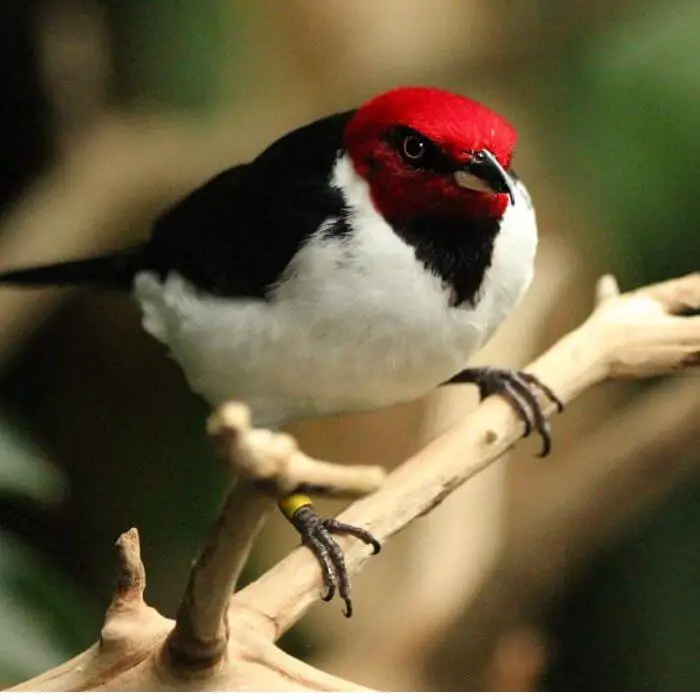
source: the.windhover
The red capped cardinal is a South American bird species that is known for its striking red head plumage. It is a common resident in woodlands, gardens, and parks. The bird is a favorite among bird watchers and photographers.
Identification:
A member of the songbird family, males and females share similar characteristics. The have a bright red head, black upperparts and white underparts. They also have stunning red eyes. Immature red-capped cardinals are duller with brown heads.
Interesting facts:
It builds its nest around swamps, mangroves or near other water bodies. However, you can still find a few birds in parks and urban settings.
16. Red-headed finch
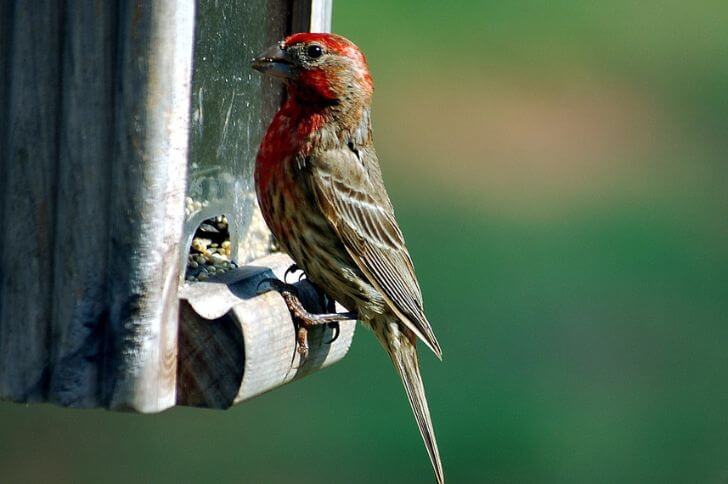
Red-headed finches, also known as paradise finches, are small birds native to Africa. The red-headed finch is one of the most strikingly colored birds you can watch on the dry savannahs.
Identification:
The males head is a bright red white the upperparts are gray. Its front is boldly black and white barred. Notice the thick triangular bill. Females are also gray-brown on the back and barred below.
Interesting facts:
The red-headed finch is found in open woodlands, savannas, and forest edges. They build their nests in trees, using grasses and twigs. They typically lay two to four eggs per clutch.The diet of the red-headed finch consists mainly of insects and seeds.
17. Masked cardinals

source: trinilab
Endemic to Venezuela and Colombia, the masked cardinal is a stunning bird that spots three distinctive colors.
Identification:
The adult has a black eye mask, red head, black upperparts and white underneath. These birds are relatively small, measuring only 9-10 inches in length. Juveniles are gray-brown above and pale below.
Interesting facts:
These birds are mostly active during the day, but they can also be seen at dawn and dusk. The diet of the masked cardinal consists mainly of flying insects and seeds. They will also eat berries and fruits. These birds are important to the ecosystem because they help control insect populations.
18. Red-faced Warbler
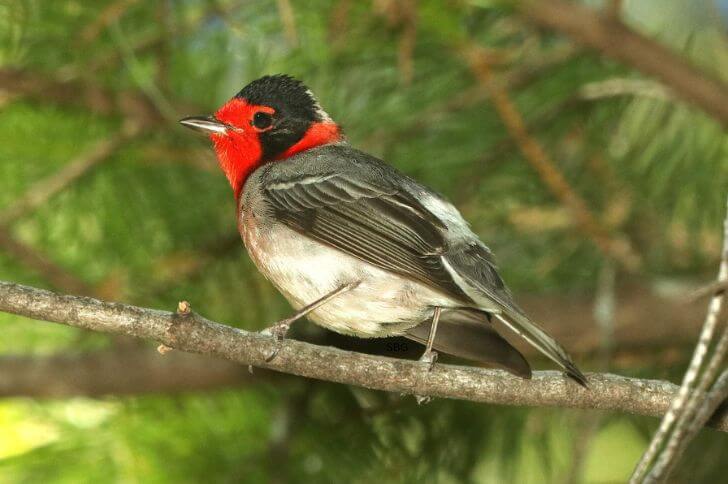
Preferring forests in oak and conifer trees, red-faced warblers are medium-sized songbirds that are members of the New World warbler family.
Identification:
Female and male have similar plumage. The adult has a red face and throat, with the rest of its upperparts being grayish-brown. They also have a black cap and a re white below. They are about 5.5 inches in size and an 8.3 wingspan.
Interesting facts:
These birds are found in pine-oak forests, mostly in higher elevations. It is an insectivorous bird, feeding primarily on caterpillars and other small insects. These birds are active during the day, and can often be seen flitting about in the treetops as they search for food. The Red-faced Warbler’s song is a series of high-pitched notes that descend in pitch towards the end.
19. Two-barred crossbill

The white-winged crossbill or the two barred crossbill are a small songbird of Northeastern Europe.
Identification:
They are known for their unusual bill, which is crossed at the tips. Also, males and females are different. The male two-barred crossbill has a dull-red head, black and white wings, and pale undertail. In contrast, females are brown-gray.
Interesting facts:
These crossbills are about 7 inches long and a wingspan of up to 11 inches. They lay white speckled eggs. This bird will rarely visit a bird feeder and is known for its tooting and rattling sounds.
20. Acorn woodpecker

The acorn woodpecker is a small bird that is found in North and South America. These birds are known for their love of acorns, which they store in holes that they drill in trees.
The acorn woodpecker is an important part of the ecosystem because they help to disperse the seeds of the oak tree.
Identification:
The acorn woodpecker has black upperparts, is white below with black stripes and stunning yellow eyes. Notice the white face with a black patch around the bill, very unique.
Males have a red cap while females have a black cap but have a red patch at the back of their head. These birds are between 7.5-9.0 inches long and have a wingspan of 13.8-16.9 inches.
Interesting facts:
The acorn woodpecker is a member of the family Picidae, which includes other woodpeckers such as the red-headed woodpecker and the yellow-bellied sapsucker. They are residents in Southwestern United States.
During the breeding season, they lay 3-6 eggs that are about 1.1 inches in length. Acorn woodpecker babies are blind and helpless for the first few days of their lives.
21. Common redpoll
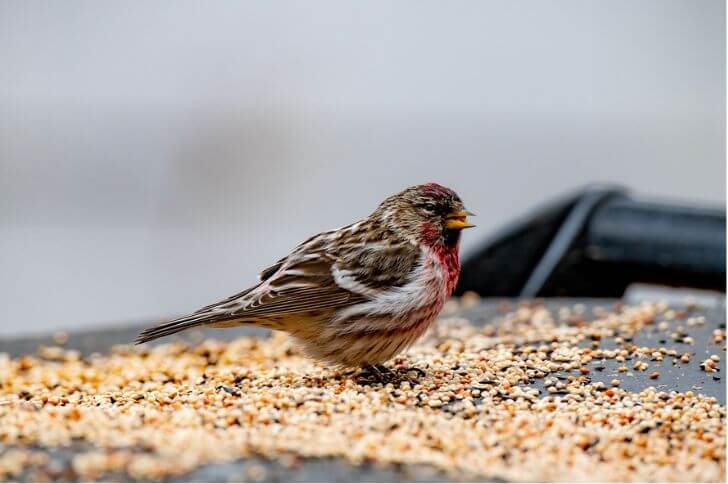
Common redpolls are small songbirds that are found in many parts of the world. The bird is most commonly seen in Eurasia, but can also be found in North America and Africa.
Identification:
The common redpoll is a very shy bird, and is not often seen by people. However, the bird can be identified by its reddish plumage on the head and chest and brown-black streaks on its wings. Females have similar coloration without the red chest.
Other facts:
What do common redpolls eat? They favor small seeds from alder, spruce and pine trees. Occasionally, they will also indulge in berries. They lay pale green-blue eggs that hatch after two weeks. Nests are usually made of twigs, tree moss and roots.
22. Pine grosbeak

Pine grosbeaks or the Pinicola enucleator are medium-sized songbirds that breed in the forests of North America and northern Eurasia.
Identification:
The males are brightly colored, with red plumage on their head, upperparts and underparts. Female pine grosbeaks are gray with an orange-yellow head. Immature birds are the same color as females.
Other facts:
Pine grosbeaks eat a variety of seeds, fruits, and insects, and often visit bird feeders during the winter months.
How rare are these birds? The Pine grosbeak birds are doing well and are not considered to be threatened. Like the common redpoll, they also lay bluish eggs but with speckles.
22. Purple finch

Purple finches do not fit the list of black and white birds with red heads to a T but we’ve included it on this list because it also spots a red head.
Identification:
The purple finch is a beautiful North American songbird. The male has a reddish-purple body and the female is more brown-gray and streaked. Both sexes have conical bills that are perfect for their main diet; seeds.
Interesting facts:
The purple finch is about the same size as a house finch and is closely related to it. These birds are often seen in woods and forest edges, where they build their nests.
The purple finch eats mostly insects and seeds. You can attract them to your backyard by providing bird feeders with nyjer seed or sunflower kernels.
23. Scarlet tanager

The scarlet tanager is a brightly colored bird that is found in wooded areas of the eastern United States.
Identification:
The male scarlet tanager is a striking red color with black wings and white underwings. The female is a yellowish-green. The scarlet tanager is a small bird, measuring only about 6.3-6.7 inches in length.
Interesting facts:
The diet of the scarlet tanager consists mainly of insects, which it catches by swooping down from branches or trees. In addition to insects, the scarlet tanager also eats berries and fruits. The scarlet tanager breeds in the spring and summer months, nesting in trees or shrubs.
The Scarlet Tanager is not currently considered to be at risk for extinction. Their songs are a series of chippuring phrases.
24. Redhead Duck

Redhead Ducks are a species of duck that is known for its red head. This black and white bird with red head is a North American species of duck that breeds in western Canada and the northern United States.
Identification:
The Redhead Duck is a medium-sized diving duck. The adult male has a gray back, a brick red head and black breast. Notice the striking yellow eyes. The adult female has a brownish body and black eyes. Notice the thick bills.
Interesting facts:
The Redhead Duck is an excellent swimmer and diver. It feeds on aquatic plants, insects, crustaceans, mollusks, fish, and small mammals.
25. Downy woodpeckers

In North America there are various small birds including downy woodpeckers. They are around six inches long and have a wingspan of about 9-11 inches.
Identification:
Downy woodpeckers are striped black and white with a red nape. Their underparts are white. Notice the sharp black bill.
Other facts:
Downy woodpeckers eat insects, spiders, and fruit. They live in forests, parks, and yards. Downy woodpeckers can be seen year-round in North America.
26. Pileated woodpecker
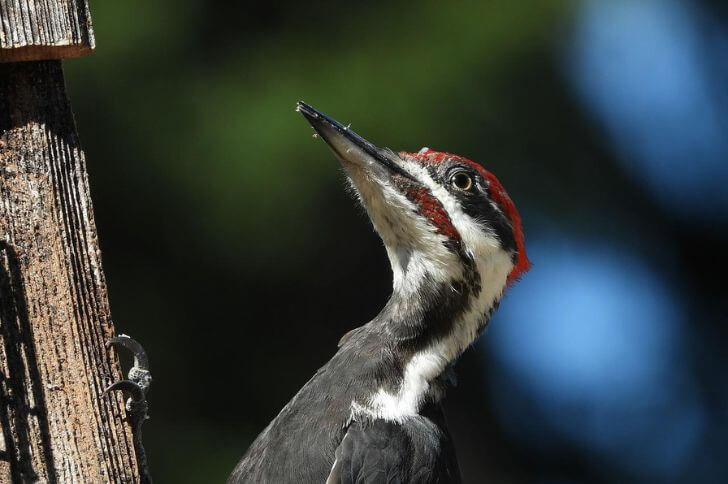
Another group of black and white birds with redheads are the pileated woodpeckers. These members of the woodpecker family.
Identification:
Large and easy to spot, the pileated woodpecker is the second largest woodpecker in the United States, and has a characteristic red crest on its head. The rest of the pileated woodpecker’s body is black and white.
Interesting facts:
These woodpeckers are forest birds that live in old-growth forests and can be found near swamps, rivers, and other wet areas. They eat insects and other small animals, and also search for food on dead trees.
Pileated woodpeckers nest in tree cavities, either natural or excavated by the birds themselves. They are monogamous, and the female builds the nest and incubates the eggs.
27. Yellow-billed cardinals
The yellow billed cardinal is a brightly colored bird that can be found in Hawaii. These black and white birds with red heads are easily identifiable by their bright red feathers on the head, yellow bill, white collar and underparts and black upperparts.
Yellow billed cardinals typically live in woodland areas, where they feed on insects and seeds. These birds are very social, and can often be found in flocks of up to 100 birds. Yellow billed cardinals are monogamous, and both the male and female take turns incubating the eggs.
Final Thoughts on the black and white bird with red head
Birds come in a variety of gorgeous colors. And if you are an avid bird watcher, I recommend you add some of these birds to your list. There are various black and white birds with red heads that you can find in the United States and in other parts of the world. From the woodpecker family to cardinals to myzomela birds, there are plenty of birds you can see.
Sources:
https://animalia.bio/yellow-billed-cardinal
https://en.wikipedia.org/wiki/Acorn_woodpecker
Hi, my name is Steve. My friend and I started the spanishbirdguides.com to share our passion with other like-minded people. So, if bird watching is your thing, you’ll love this blog. I’ll share what I’ve learnt about both local birds and those found in other parts of the world. Also, I’d love to hear your experiences.



